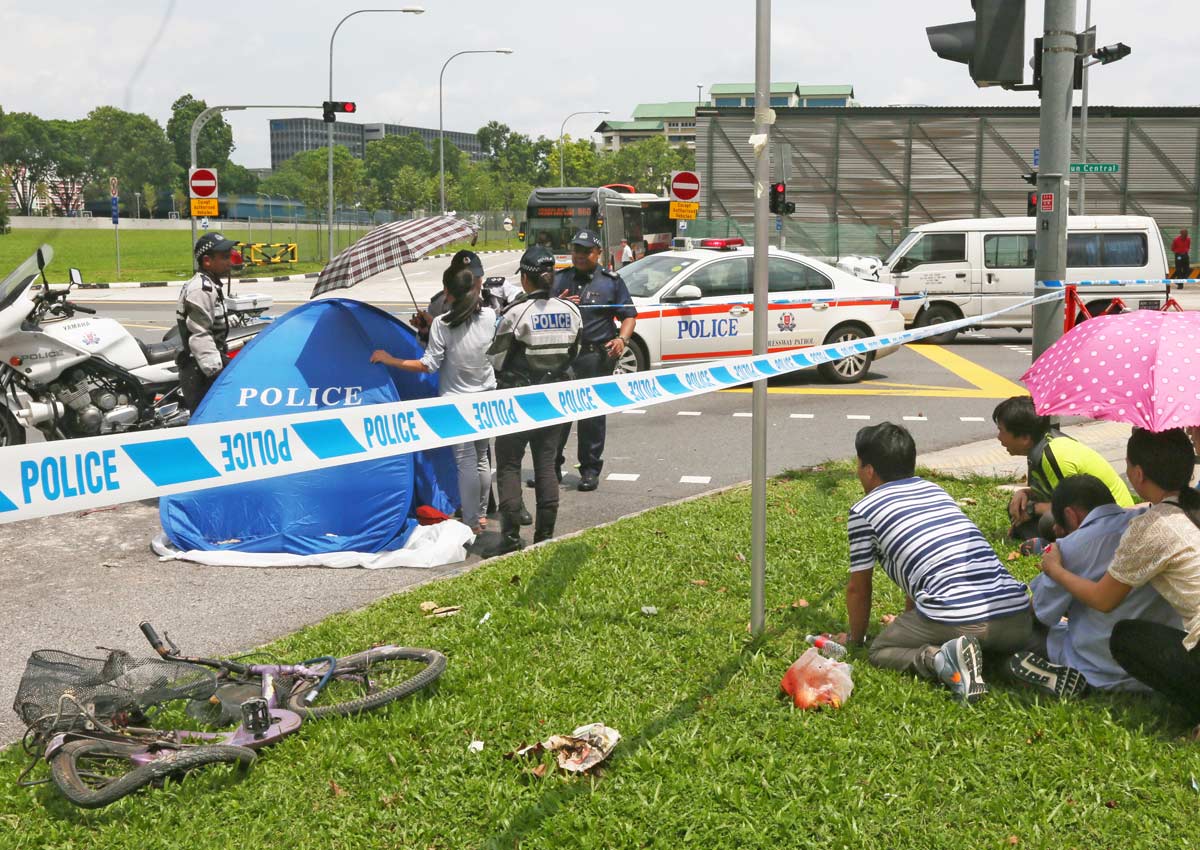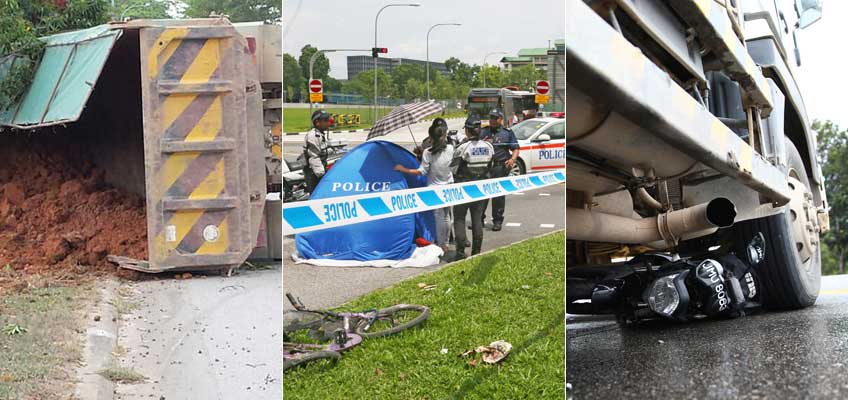He shuddered when he read about a cyclist who died after she was hit by a cement truck on Monday.
“The hair on my arms stood,” Mr John Liang, 39, told The New Paper.
Madam Lin Shui Yu, 59, was hit while cycling on a pedestrian crossing in Yishun Central. She was cycling with two of her friends.
Why does this keep happening, wondered Mr Liang.
In March last year, he was cycling along Changi Coastal Road when a tipper truck hit him from behind.
Mr Liang was flung “several metres” and landed on the grass verge, head first.
“Thank God, I had my helmet tightly strapped to my head. Yet it came off and the inside split in two, like a watermelon,” said the cycling enthusiast.
“I suffered 10 broken ribs and a broken collarbone. There was also a blood clot in my brain.
“Can you imagine what would have happened if I wasn’t wearing a helmet?”
Mr Liang lost consciousness “for about 30 seconds after the landing” and when he came to, the first thing he saw was the tipper truck lying on its side.
He said: “The condition on the road that day was perfect – the sun was shining, the roads were dry and traffic was not heavy.
“There was no possibility of bad vision or the vehicle skidding. Then this happened.
“Witnesses who ran over to help me told me that after it hit me, the truck swerved and hit two trees before landing on its side.”
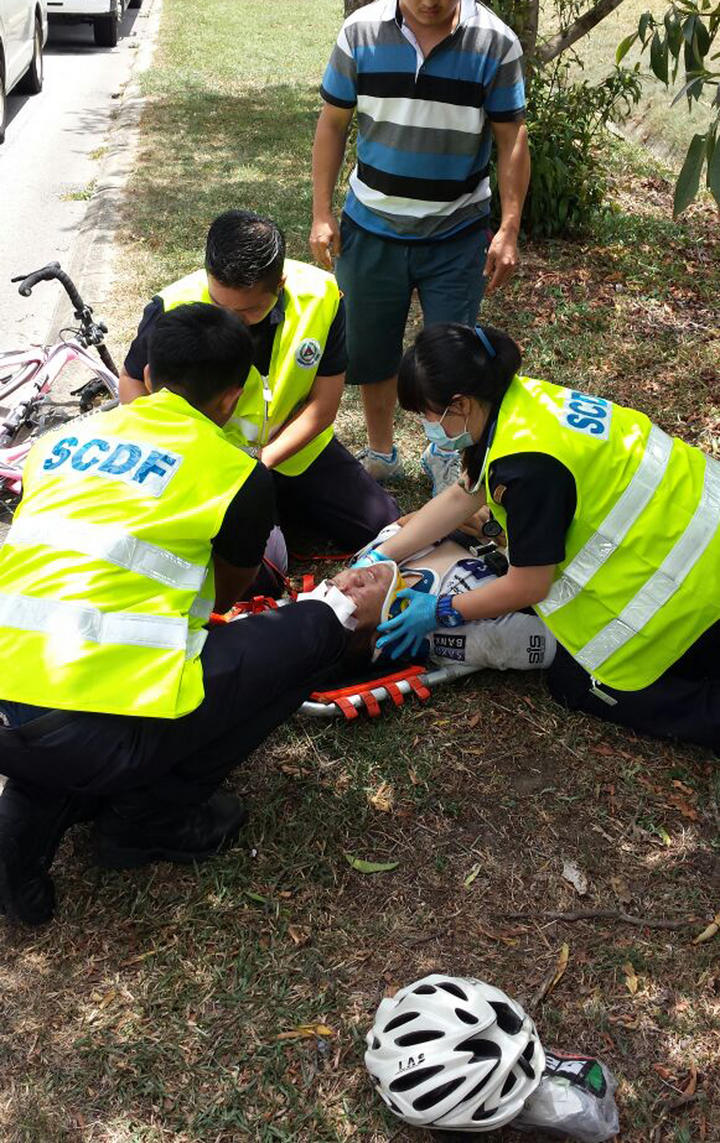
Mr Liang believes that the truck driver was a foreign national who had been on the job for only a month.
This could not be verified.
“The irony was he managed to escape unscathed,” Mr Liang said.
Despite being in excruciating pain, Mr Liang still had his wits about him.
“I was able to give my wife’s contact number to the passers-by and ask them to send photos of the accident scene to her,” he recalled.
SURGERY
Mr Liang was taken to Changi General Hospital and warded for three days.
“I underwent surgery to have tubes inserted into me to drain the blood, just in case the broken ribs stabbed and punctured my lungs,” he said.
“But I didn’t go through any operation to repair my ribs or collarbone. They healed on their own. I was also given morphine to manage the pain.”
Mr Liang was on medical leave for two months after he was discharged from the hospital and spent the next nine months trying to recover.
He was given painkillers.
“I couldn’t sleep well. I would be jolted awake by the pain if I were to turn in my sleep,” he said.
“I am still recovering. Every six months, I would have to return to the hospital for my check-up to make sure my collarbone is healing well.
“It hasn’t fully healed. I was told there is still 5mm more to grow before it becomes whole again.”
The clot in his brain has slowly dissipated.
Mr Liang has yet to get back in the saddle.
“It has been a year and I still feel the apprehension,” he said.
“The lack of exercise has piled on the weight. I need to get fit again. I need to conquer my fear and get back to riding soon.
“I hope by telling my story, I’ll be able to persuade the authorities to look into the industry which allows foreigners to drive big vehicles before they are familiar with our roads.
“They also have to look into the drivers’ long hours and their driving speed.”
Mr Liang does not know what became of the driver who hit him.
“Something needs to be done before more people are killed on the roads unnecessarily,” he added.
IT’S ALL ABOUT THE MONEY
The figures are grim.
The number of accidents involving heavy vehicles causing injury or death has been rising.
In 2013, there were 816 such accidents. It was 839 in 2014 and 877 last year.
Why?
Heavy vehicle drivers point the finger squarely at the way they are paid.
They declined to be identified for fear of losing their jobs.
“We make about $18 to $20 a trip, $12 to $13 if the trips are shorter,” one said.
They also blame foreign drivers, whom they say try to make as many trips as possible to maximise their short stay here.
Most of the drivers are foreign workers from India and China, he claimed.
“So to them, the amount of money matters because of the currency exchange. That’s why they piah (Hokkien for rush),” said the local driver of five years.
Eight months after the horrific accident in 2013 where a concrete truck killed two brothers aged 13 and seven, the Workplace Safety and Health Council proposed that commercial drivers be given a fixed salary to help reduce deaths on the road.
There has been no news since the proposal.
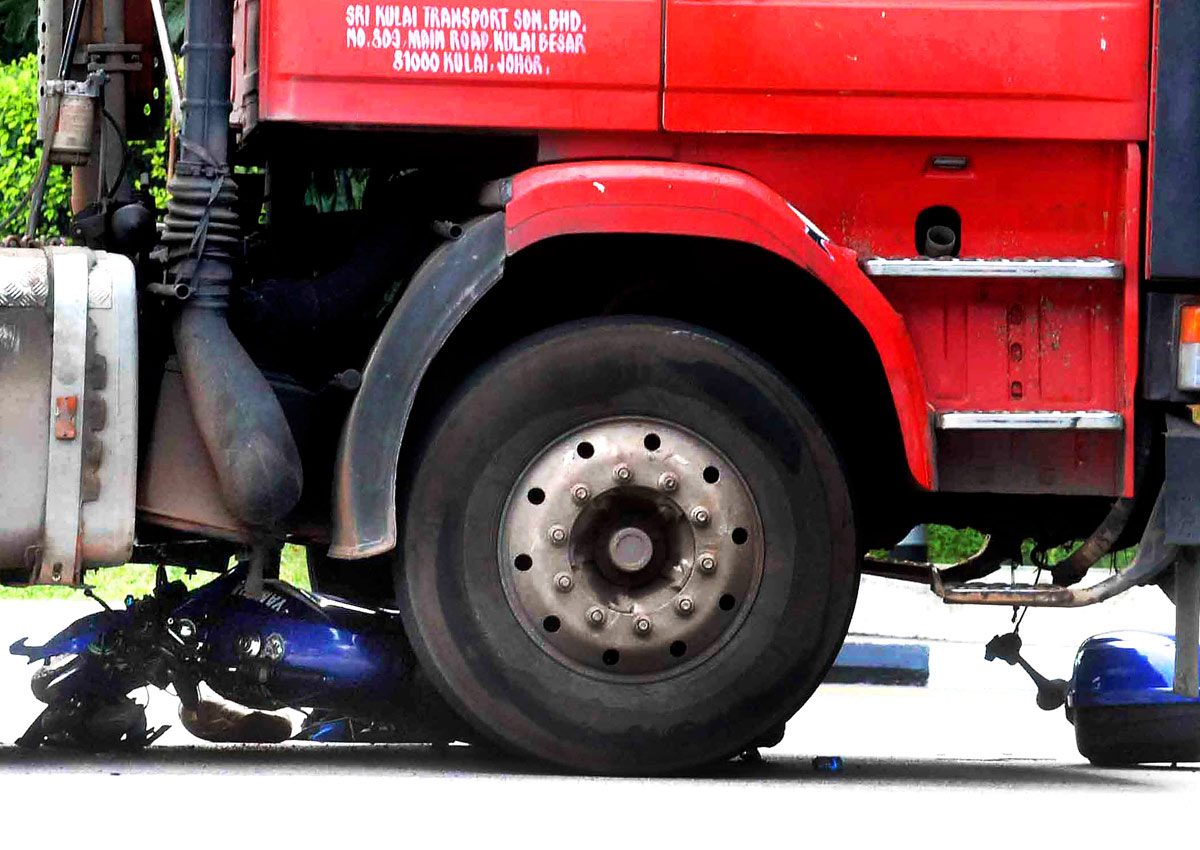 The number of accidents involving heavy vehicles causing injury or death has been rising. Photo: ShinMin
The number of accidents involving heavy vehicles causing injury or death has been rising. Photo: ShinMin
Bok Seng Logistics group chief executive officer Dave Ng said the pay-per-trip system is merely an incentive for drivers to complete the jobs assigned.
They are also paid a basic salary. He declined to be specific or give a range.
To ensure his company’s 90 heavy vehicle drivers are mindful of road safety for themselves and others, he installed a hi-tech road safety device in his fleet.
Called Mobileye, it is a driver-warning system that can sense road markings, pedestrians and other road users, alerting the driver if there is a potentially dangerous situation.
It also keeps a log of the mistakes made, which can be accessed by the company and shared with the authorities.
Is there a need for tougher laws?
In Singapore, drivers who kill others in a road accident can be charged with causing death by a negligent act. That carries a suspension and up to two years’ jail with the possibility of a fine.
RECKLESS
In the United States, causing death due to illegal driving of an automobile, including gross negligence, drink driving, reckless driving or speeding, is classified as vehicular manslaughter or vehicular homicide. The penalties range from three to 15 years’ jail and between five and 20 years for habitual violators.
After the Tampines accident in 2013, Member of Parliament for Tampines GRC Baey Yam Keng campaigned for heavy vehicles to be kept away from schools and residential areas.
He has had some success. (See report below.)
Mr Baey feels the law as it stands now is sufficient. He said the law already makes a distinction if the driver is negligent or reckless and provides for punishment according to the crime.
“Most importantly, when you get behind the wheel, top of mind must be the safety of those in your vehicle and of other road users.
Always pre-empt and anticipate,” he said.
The cement truck driver in the Tampines accident pleaded guilty to causing the death of the brothers. He was jailed two weeks in 2014 and banned from driving for five years.
MP’s fight to slow trucks down
On Jan 28, 2013, a cement truck killed two brothers who were riding a bicycle at a pedestrian crossing in Tampines.
Tampines MP Baey Yam Keng then called for heavy vehicles to be kept out of residential areas.
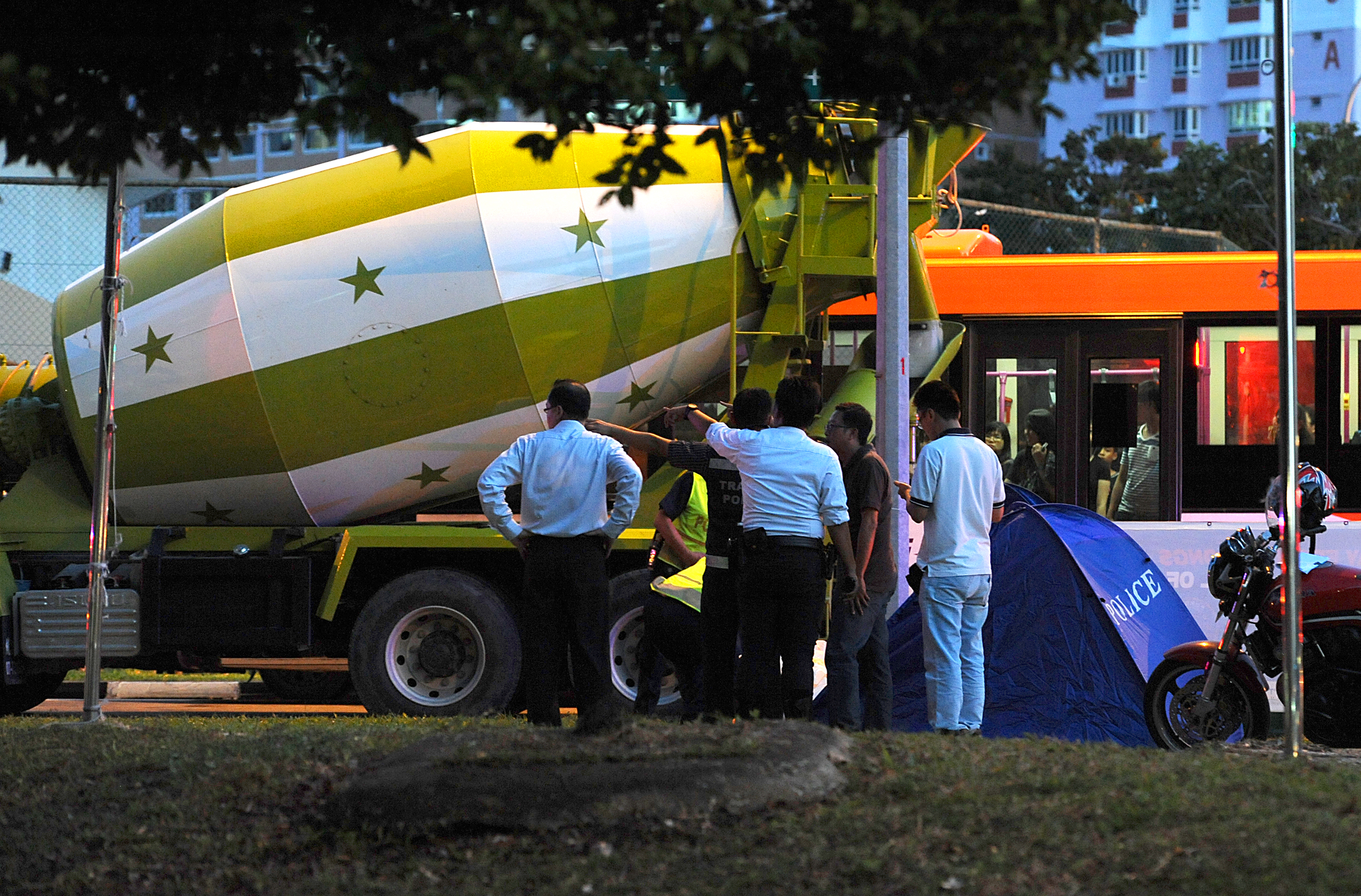 The driver of this cement truck hit two brothers, aged 13 and seven, who were crossing a traffic light junction in January 2013. Photo: The New Paper
The driver of this cement truck hit two brothers, aged 13 and seven, who were crossing a traffic light junction in January 2013. Photo: The New Paper
He wanted the Housing Board and the Land Transport Authority (LTA) to find a safer route that heavy vehicles could take in his constituency, away from schools or pedestrian crossings. But that proved impractical as construction sites are often within residential areas.
Mr Baey, who is also Parliamentary Secretary, Ministry of Culture, Community and Youth, pressed for changes.
SLOW DOWN
“I’ve seen in Tampines narrower streets with wider dividers, to force drivers to slow down,” said Mr Baey.
“Roads that were once straight are now curvy. This is another tactic to slow drivers down in residential areas.
“I feel that such physical conditions make people behave differently on the roads. LTA is trying.”
These changes are part of what LTA terms Silver Zones to improve road safety for elderly pedestrians, a spokesman said.
LTA has completed seven Silver Zones (Bedok, Bukit Merah View, Jurong West Street 52, Lengkok Bahru, Tampines, Woodlands and Yishun). Eight more will be completed by next year.
LTA intends to implement 35 Silver Zones in residential estates by 2020.
Some moves by police and LTA
A police spokesman said drivers of heavy vehicles are put through training for further driving skills at the driving schools.
The authorities also conducted road safety sessions. As recent as April, the traffic police, together with the Singapore Road Safety Council, held a Road Sense seminar and dialogue session with them, to discuss how best road performance can be achieved, the spokesman said.
In March 2015, the mirrors for blind spots were implemented.
A spokesman for the Land Transport Authority said the mirrors of more than nine in 10 of 18,600 existing heavy goods vehicles, with maximum laden weight exceeding 12 tonnes, comply with European or Japanese mirror standards.
The spokesman added: “These vehicles are checked to ensure that blind-spot mirror requirements are met during mandatory periodic vehicle inspections from October 2015.
“Non-compliant vehicles will not be able to pass the inspections and are required to rectify the issue before proceeding for a re-inspection.”

This article was first published on May 25, 2016.
Get The New Paper for more stories.
